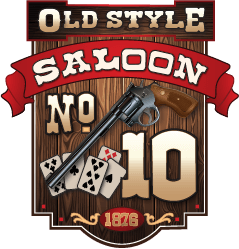History
Deadwood’s Rowdiest Chapter: The Story of Saloon No. 10
Saloon No. 10’s rich history begins in the 1930s when a man named Stu Donavitz, who had previously operated a speakeasy, decided to open a new establishment at what is now the current location of Saloon No. 10. He named the bar “Old Style” and envisioned a place that would become a cornerstone of Deadwood’s social scene. One of the key figures in shaping the bar’s legacy was Elmer Kellogg, a cartoonist for the Chicago Police Gazette during the 1930s. After being fired from his job, Elmer drifted into Deadwood and befriended Stu. He shared his vision with Stu, telling him, “I know how you can make a million bucks. You should create the Saloon No. 10 where Wild Bill was killed.” Elmer believed that reviving the legend of the Saloon No. 10 would draw people to Deadwood, and he was right.
Together, they recreated the front room of the saloon to reflect what the original Saloon No. 10 might have looked like. Elmer personally crafted the large doors, bar stools, barrel stools, and fireplace. The collection of items that would eventually fill the bar began right from the start, with stories and memories passed down through the years. At that time, Deadwood was striving to attract tourists, trying to capitalize on the fame of Mount Rushmore, while Lead had the gold mine to boast about. Elmer’s foresight and vision proved to be spot-on, and Saloon No. 10 became a hub for visitors and locals alike, ensuring that the legend of Wild Bill Hickok, Calamity Jane, and the Wild West would continue to live on.
In December of 1963, Lew and Marion Keehn purchased Saloon No. 10 from Stu Donavitz. Since then, the family has carried on the bar’s legacy. Today, seven members of the Keehn family are actively involved in the day-to-day operations, continuing a tradition that has been passed down through four generations.
Saloon No. 10 has always been more than just a bar; it’s been a gathering place for both locals and visitors. The family fondly remembers their father inviting friends and new acquaintances to grill steaks over the front room fireplace while a blizzard raged outside. Live music was also an important part of the atmosphere, with local musicians like Vern Sympsy and Jeannie playing the Hammond organ. On occasion, their dad would join in with the “gut bucket,” adding his own flair to the music. In the late 60s, a stage was built in the back room for local rock and roll bands, and Saloon No. 10 became a lively hub for music and entertainment in Deadwood.
In the mid-1980s, the family saw the need to offer food in order to keep customers around for another drink or two. In 1986, they added a small kitchen and launched Aunt Sally’s Fried Chicken. The menu included broasted chicken, coleslaw, barbecue ribs, and Jo-Jos, served through a simple dumbwaiter called the “chicken shoot” that connected the two levels of the saloon.The demand for food grew, leading the family to open the Deadwood Social Club on December 1, 1995. This larger venue offered an expanded menu while preserving the rich history of Saloon No. 10. Since then, it has become a key part of the community, carrying on the family’s tradition of great food, drinks, and entertainment.
Throughout the years, the family has been grateful for the memories tied to each accomplishment. They have learned from their parents the importance of giving back to the community, a value that continues to be a core part of the business. Raising money for various causes has always been a creative endeavor, sometimes spiked with a touch of insanity, but it’s always been an adventure. The mantras passed down from their parents—”Keep the faith,” “This too shall pass,” and “Life is short”—have remained a guiding force. Despite the challenges, they believe there has been more laughter than tears along the way. Running a family business is never easy, but they believe that if they had a different set of parents, things might not have had so many happy endings. They fight, but they love each other, and it’s this strong bond that has helped Saloon No. 10 continue to thrive.
Photos Courtesy of Deadwood History, Inc., Adams Museum Collection.






